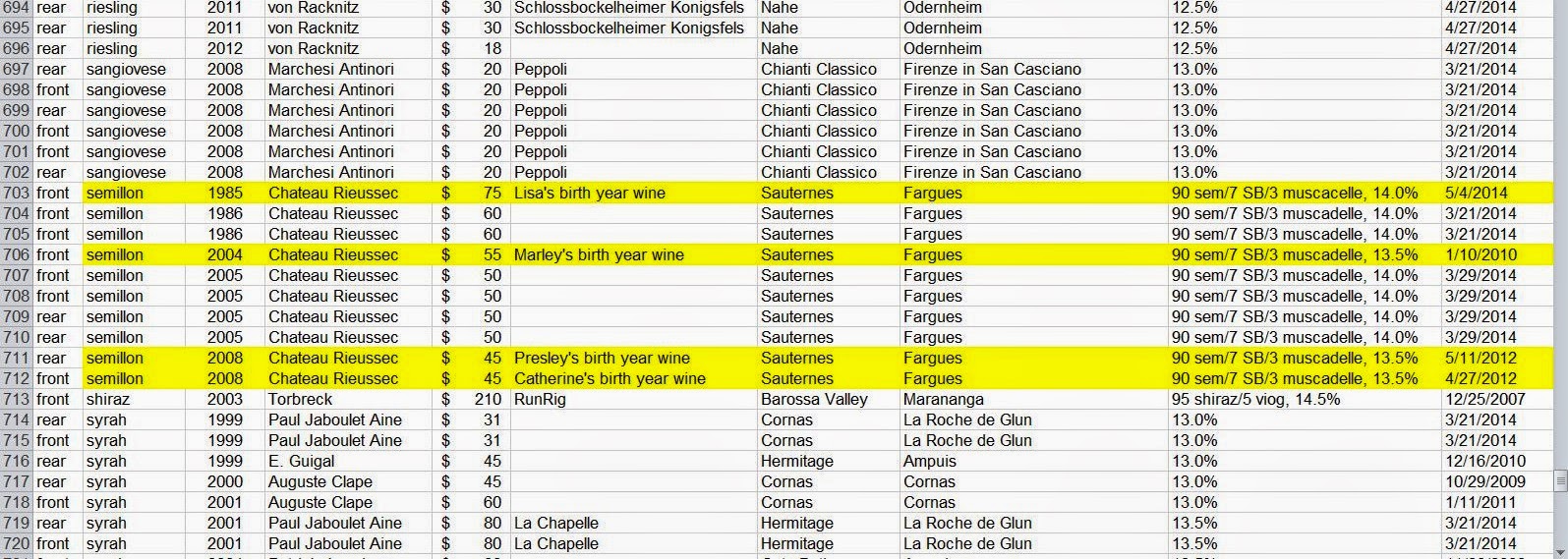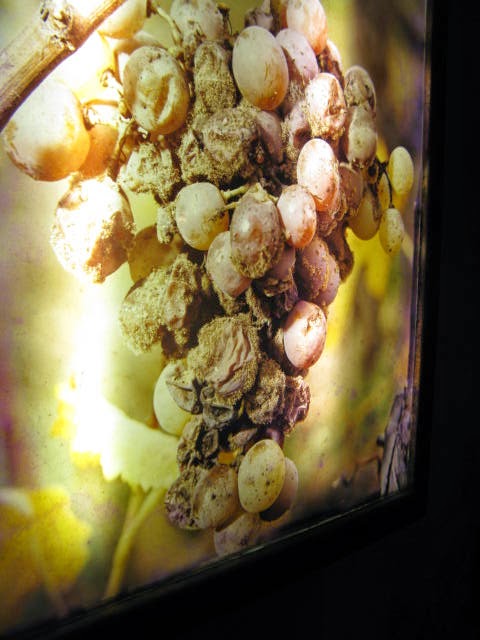Bonjour les amis! Hello, friends and welcome back to Cépage et Cuisine, Mary’s
and Brian’s wine and food blog. We’re
continuing with our exploration of the Bordeaux region on our wine, cuisine, and
cultural vacation in France.
I drove
this morning to Montagne where there is an honest-to-goodness boulangerie. On the way, there is this tiny chapel in a
vineyard. It’s a little bigger than a
vineyard tool shed.
I didn’t learn
anything about its history, how long it has been there, whether it was part of
a larger community. It’s just out there
in the middle of a vineyard.
Perhaps
there’s a relationship with this nearby château. If we ever return here, I’d like to learn
more about it. In any event, it’s a
beautiful image, ornate in its architecture, sitting among the vines, very
peaceful.
Montagne
is an ancient village, evidenced by the church’s Romanesque style, which is
older than the Gothic style of Saint-Christophe-des-Bardes and even Saint
Émilion.
The
boulangerie prize of the day was a tartelette
aux pommes, an apple tart.
Today is
Sauternes day, about an hour’s drive to the southwest, across the
Entre-Deux-Mers and on the other side of the Garonne River.
Below again is the Bordeaux map, again with credit to Wine Spectator.
We’re
based just to the east of Saint Émilion.
You can see the Sauternes appellation
and the village of Sauternes is in the far southwest part of the map.
As we
made our way down through the rural stretches of the Entre-Deux-Mers, we were
startled to see one of these critters dart out in front of us!
Neither of us has ever seen a live wild boar
before. That guy came tearing out of a
vineyard to our left, running in a flat-out, full gallop across the road, and
disappeared into the bushes and trees on the other side. That was one fast pig!
Our
appointment at Château Rieussec was for 2:00 p.m. and we planned to have lunch
in Sauternes. Despite
being so famous in the world of wine, Sauternes is a very small town.
One of only a couple of places for lunch is
Auberge les Vignes, which translates to inn of the vines.
It’s just a little place across from the
church, en face à l'église.
It was a
chilly, damp day and there was no room at the inn.
We were offered a table on the terrace under
an umbrella, which we accepted. We were
partially successful in dodging the raindrops.
Here's the formule for the day.
We both
selected a salad of melon jambon,
cantaloupe and thinly sliced ham, similar to prosciutto. You can see a carafe of the house white wine,
which was a simple Bordeaux blanc, fresh and light and designed to pair with a
simple meal.
Le plat was poulet fermier roti, roast chicken with fries and spinach. It was just delicious, cooked perfectly,
moist and flavorful.
Along
with our fruit salad dessert and since we were having lunch in Sauternes the
village, we wanted to have a glass of Sauternes the wine.
No surprise, the wine list included lots of choices of Sauternes. We selected a glass of Château d’Arche 2010. It was sweet, of course, but the sweetness
was balanced by fresh acidity, not at all cloying. It had those wonderful Sauternes aromas of
citrus and tropical fruit notes and the palate was clean, smooth, and refreshing
with spice, grapefruit, sort of a lemon candy quality, and a perfectly ripe
white peach.
Amazingly and right here in a hometown café, Château d’Yquem 1975 was listed for a cool €1,560, about $2,175
per bottle.
Sauternes
is a wine we drink pretty much on special occasions and usually when we’re
hosting guests. It is a dessert wine and
can stand on its own as dessert or can be paired with fruit or cheeses,
particularly strong cheeses like a Roquefort. It is a
wine that rewards aging. The structure
and balance of acidity, sweetness, and moderate alcohol levels allow it to age
gracefully, perhaps more reliably than many wines.
Below is a screenshot from our wine collection inventory.
Mary and I buy birth year wines for all the
grandchildren with a plan to lay them down in our collection under temperature
and humidity-controlled storage conditions, then celebrate with them sometime
after they turn age 21. I think
Sauternes is a great choice for such a wine.
We even managed to procure one recently from Lisa’s birth year.
Château
Rieussec is our favorite Sauternes producer.
It is reliably excellent, not too hard to find, and the price point is
not out of reach for a special occasion wine.
Here’s a
little background on Sauternes. There
are five communes in the appellation. They are Sauternes, Fargues, Barsac,
Preignac, and Bommes. Like the Medoc
producers, it is grouped in the 1855 classification into growths or crus.
There are three of these. The top
level is Premier Cru Supérieur, Superior First Growth. There is one and only one producer in this
category, which is Château d’Yquem.
The next category is Premier Crus Classé, First
Growths. There are 11 producers in this
group, including Château Rieussec, as you can see in this label photo. The Deuxièmes Crus Classé, Second Growths,
include 12 more producers. All the
others, numbering more than 250, can include Sauternes on their labels but
cannot claim classified growth status.
There is a small tributary of La Garonne in the Sauternes area called Le
Ciron. Mists form between the two rivers
on autumn evenings that settle in the vineyards overnight. A fungus called Botrytis cinerea, termed “noble rot” in the wine world, attacks the
grapes, reducing their water content.
The sugar, acidity, and flavor compounds are concentrated into a rich
nectar as a result. The grapes are then picked,
berry by berry in numerous passes through the vineyard, called tries (pronounced “trees”) as they reach
the desired degree of dehydration. This
photo illustrates Botrytis-infected grapes.
Camille,
our delightful guide, took us first to the vineyard on a chilly, drizzly
afternoon.
She showed us how the vines
are pruned in winter for the desired number of new shoots during the growing
season. The property totals 93 hectares,
about 230 acres.
Here, you
can see what Camille calls the “babies.”
Just on
the other side of the Château Rieussec vineyards is the adjoining property of Château
d’Yquem.
Like many
estates in Bordeaux, roses grow at the end of the vineyard rows.
Camille
walked us through the technical production area. Here is the destemmer.
These
stainless steel fermentation vats are interesting as they are actually two
vats, one on top of the other.
Here is
the barrel aging room, where the wines are stored for 18-26 months. This is the entire production of Château
Rieussec for one year, about 72,000 bottles or 6,000 cases for the entire world
market. It is their best wine. In poor vintages, they may not bottle it at
all, such as in 2012. They make a lesser
wine, called a “second label”, which has higher production.
Sauternes
is mostly comprised of Semillon, more than 90% in the case of Château Rieussec,
along with a little Sauvignon Blanc and Muscadelle. Here’s Camille, opening the 2011.
Look how
pretty it is, golden and rich. The first
impression that comes to me is flowers, especially honeysuckle or
gardenia. There’s also a distinct
grapefruit citrus and apricot quality.
The flavor profile is powerfully intense with both fresh and dried fruit
flavors, peach, apricot, orange and grapefruit citrus, along with a little
nutmeg or allspice. I’ve often heard it
described as similar in some ways to the flavor of crème brulée. Overlaying it all is excellent balancing
acidity and energy. It was so delicious we
just stood there for a while and sipped slowly.
Heading
back to the gite we stopped to photograph this
building in the town of Le Plan sur Garonne.
Nowadays it is the maire, the
mayor’s office, and a community center.
In a previous life, it was the school.
Carved over the windows on one is Ecole
de Garçons, school for boys.
On the
other end is Ecole de Filles. Mary says she thinks it’s a good idea.
A little
farther along is Sauveterre de Guyenne, an old bastide town.
The ancient gates to the town are remaining.
We picked
up charcuterie, cheese, and fruit for a dinner snack back at the gite and
enjoyed it with this Burgundy that was gifted to us by Marie and Yves as we
left Magny-les-Villers.
That’s our post for
today. We hope you enjoyed it. Thanks so much for reading us. We have two more days in Bordeaux before
heading home, so we have more to share. Keep
checking back at Cépage et
Cuisine as we continue our wine, food, and cultural vacation
in Bordeaux. In the meantime,
Cheers!
Mary♥Brian









































No comments:
Post a Comment